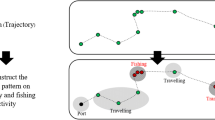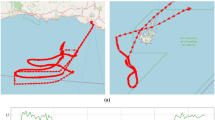Abstract
Vessel Monitoring System (VMS) provides a new opportunity for quantified fishing research. Many approaches have been proposed to recognize fishing activities with VMS trajectories based on the types of fishing vessels. However, one research problem is still calling for solutions, how to identify the fishing vessel type based on only VMS trajectories. This problem is important because it requires the fishing vessel type as a preliminary to recognize fishing activities from VMS trajectories. This paper proposes fishing vessel type identification scheme (FVID) based only on VMS trajectories. FVID exploits feature engineering and machine learning schemes of XGBoost as its two key blocks and classifies fishing vessels into nine types. The dataset contains all the fishing vessel trajectories in the East China Sea in March 2017, including 10031 pre-registered fishing vessels and 1350 unregistered vessels of unknown types. In order to verify type identification accuracy, we first conduct a 4-fold cross-validation on the trajectories of registered fishing vessels. The classification accuracy is 95.42%. We then apply FVID to the unregistered fishing vessels to identify their types. After classifying the unregistered fishing vessel types, their fishing activities are further recognized based upon their types. At last, we calculate and compare the fishing density distribution in the East China Sea before and after applying the unregistered fishing vessels, confirming the importance of type identification of unregistered fishing vessels.
Similar content being viewed by others
References
Bastardie, F., Nielsen, J. R., Ulrich, C., Egekvist, J., and Degel, H., 2010. Detailed mapping of fishing effort and landings by coupling fishing logbooks with satellite–recorded vessel geo location. Fisheries Research, 106 (1): 41–53.
Bertrand, S., Díaz, E., and Lengaigne, M., 2008. Patterns in the spatial distribution of Peruvian anchovy (Engraulis ringens) revealed by spatially explicit fishing data. Progress in Oceanography, 79 (2–4): 379–389.
Boutell, M. R., Luo, J., Shen, X., and Brown, C. M., 2004. Learning multi–label scene classification. Pattern Recognit, 37 (9): 1757–1771.
Campanis, G., 2008. Advancements in vms data analyses. NAFO Annual Report for 2008.
Castro, J., Punzón, A., Pierce, G. J., Marín, M., and Abad, E., 2010. Identification of métiers of the Northern Spanish coastal bottom pair trawl fleet by using the partitioning method CLARA. Fisheries Research, 102 (1–2): 184–190.
Chang, S. K., 2011. Application of a vessel monitoring system to advance sustainable fisheries management–Benefits received in Taiwan. Marine Policy, 35 (2): 116–121.
Chang, S. K., Liu, K. Y., and Song, Y. H., 2010. Distant water fisheries development and vessel monitoring system implementation in Taiwan. History and driving forces. Marine Policy, 34 (3): 541–548.
Chawla, N. V., Bowyer, K. W., Hall, L. O., and Kegelmeyer, W. P., 2011. SMOTE: Synthetic minority over–sampling technique. Journal of Artificial Intelligence Research, 16 (1): 321–357.
Chen, T., and Guestrin, C., 2016. Xgboost: A scalable tree boosting system. Proceedings of the 22nd ACM SIGKDD International Conference on Knowledge Discovery and Data Mining, ACM, 785–794.
Clarkson, V., Kootsookos, P. J., and Quinn, B. G., 1994. Analysis of the variance threshold of Kay’s weighted linear predictor frequency estimator. IEEE Transactions on Signal Processing, 42 (9): 2370–2379.
Coro, G., Fortunati, L., and Pagano, P., 2013. Deriving fishing monthly effort and caught species from vessel trajectories. Oceans, IEEE, 1–5.
Cortes, C., and Vapnik, V., 1995. Support–vector networks. Machine Learning, 20 (3): 273–297.
Cover, T. M., and Hart, P. E., 1967. Nearest neighbor pattern classification. IEEE Transactions on Information Theory, 13 (1): 21–27.
Deng, R., Dichmont, C., Milton, D., Haywood, M., Vance, D., Hall, N., and Die, D., 2005. Can vessel monitoring system data also be used to study trawling intensity and population depletion? The example of Australia’s northern prawn fishery. Canadian Journal of Fisheries and Aquatic Sciences, 62 (3): 611–622.
Feng, S. H., and Lang, C. Y., 2017. Graph regularized low–rank feature mapping for multi–label learning with application to image annotation. Multidimensional Systems & Signal Processing, 11: 1–22.
García–de–la–Fuente, L., Fernández–Vázquez, E., and Ramos–Carvajal, C., 2016. A methodology for analyzing the impact of the artisanal fishing fleets on regional economies: An application for the case of Asturias (Spain). Marine Policy, 74: 165–176.
Gloaguen, P., Mahévas, S., Rivot, E., Woillez, M., Guitton, J., Vermard, Y., and Etienne, M. P., 2015. An autoregressive model to describe fishing vessel movement and activity: An autoregressive model to describe fishing vessel movement and activity. Environmetrics, 26 (1): 17–28.
Joo, R., Bertrand, S., Chaigneau, A., and Ñiquen, M., 2011. Optimization of an artificial neural network for identifying fishing set positions from VMS data: An example from the Peruvian anchovy purse seine fishery. Ecological Modelling, 222 (4): 1048–1059.
Joo, R., Salcedo, O., Gutierrez, M., Fablet, R., and Bertrand, S., 2015. Defining fishing spatial strategies from VMS data: Insights from the world’s largest monospecific fishery. Fisheries Research, 164: 223–230.
Kim, J. S., and Jeong, J. S., 2015. Pattern recognition of ship navigational data using support vector machine. The International Journal of Fuzzy Logic and Intelligent Systems, 15 (4): 268–276.
Lambert, G. I., Jennings, S., Hiddink, J. G., Hintzen, N. T., Hinz, H., Kaiser, M. J., and Murray, L. G., 2012. Implications of using alternative methods of vessel monitoring system (VMS) data analysis to describe fishing activities and impacts. ICES Journal of Marine Science, 69 (4): 682–693.
Lee, J., 2010. Developing reliable, repeatable and accessible methods to provide high–resolution estimates of fishing–effort distributions from vessel monitoring system (VMS) data. ICES Journal of Marine Science, 67 (6): 1260–1271.
Murray, L. G., Hinz, H., Hold, N., and Kaiser, M. J., 2013. The effectiveness of using CPUE data derived from vessel monitoring systems and fisheries logbooks to estimate scallop biomass. ICES Journal of Marine Science, 70 (7): 1330–1340.
Perera, L. P., Oliveira, P., and Guedes Soares, C., 2012. Maritime traffic monitoring based on vessel detection, tracking, state estimation, and trajectory prediction. IEEE Transactions on Intelligent Transportation Systems, 13 (3): 1188–1200.
Russo, T., Carpentieri, P., Fiorentino, F., Scardi, M., Cioffi, A., and Cataudella, S., 2016. Modeling landings profiles of fishing vessels: An application of self–organizing maps to VMS and logbook data. Fisheries Research, 181: 34–47.
Russo, T., Parisi, A., Prorgi, M., Boccoli, F., Cignini, I., Tordoni, M., and Cataudella, S., 2011. When behaviour reveals activity: Assigning fishing effort to métiers based on VMS data using artificial neural networks. Fisheries Research, 111 (1–2): 53–64.
Shewhart, W. A., and Wilks, S. S., 2005. Applied Logistic Regression, 2nd Edition, 1–22.
Vermard, Y., Rivot, E., Mahévas, S., Marchal, P., and Gascuel, D., 2010. Identifying fishing trip behaviour and estimating fishing effort from VMS data using Bayesian Hidden Markov Models. Ecological Modelling, 221 (15): 1757–1769.
Walker, E., and Bez, N., 2010. A pioneer validation of a statespace model of vessel trajectories (VMS) with observers’ data. Ecological Modelling, 221 (17): 2008–2017.
Wang, H., Osen, O. L., Li, G. Y., Li, W., Dai, H. N., and Zeng, W., 2015. Big data and industrial internet of things for the maritime industry in Northwestern Norway. TENCON 2015–201. IEEE Region 10 Conference IEEE, 1–5.
Wang, Q., and Dai, H. N., 2013. On modeling of eavesdropping behavior in underwater acoustic sensor networks. International Symposium on A World of Wireless, Mobile and Multimedia Networks IEEE, 1–3.
Wang, Y., Liu, Y., and Guo, Z., 2012. Three–dimensional ocean sensor networks: A survey. Journal of Ocean University of China, 11 (4): 436–450.
Williams, E., 2011. Aviation Formulary V1. 46Aviation.
Witt, M. J., and Godley, B. J., 2007. A step towards seascape scale conservation: Using Vessel Monitoring Systems (VMS) to map fishing activity. PLoS One, 2 (10): e1111.
Zong, Y., Huang, H., Hong, F., Zhen, Y., and Guo, Z., 2016. Recognizing fishing activities via VMS trace analysis based on mathematical morphology. Techno–Ocean IEEE, 465–470.
Acknowledgements
We thank the Zhejiang Ocean and Fishery Bureau for providing VMS data. This research was partially supported by National Key R&D Program (No. 2016YFC 1401900), the National Natural Science Foundation of China (Nos. 61379127, 61379128, 61572448), the Fundamental Research Funds for the Central Universities (No. 201713016), and Qingdao National Laboratory for Marine Science and Technology Open Research Project (No. QNLM2016ORP 0405).
Author information
Authors and Affiliations
Corresponding author
Rights and permissions
About this article
Cite this article
Huang, H., Hong, F., Liu, J. et al. FVID: Fishing Vessel Type Identification Based on VMS Trajectories. J. Ocean Univ. China 18, 403–412 (2019). https://doi.org/10.1007/s11802-019-3717-9
Received:
Revised:
Accepted:
Published:
Issue Date:
DOI: https://doi.org/10.1007/s11802-019-3717-9




